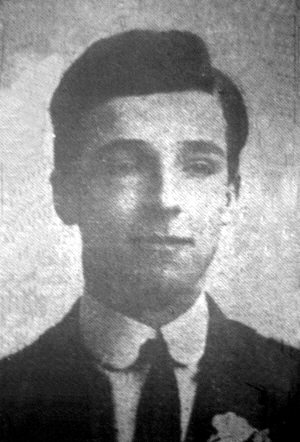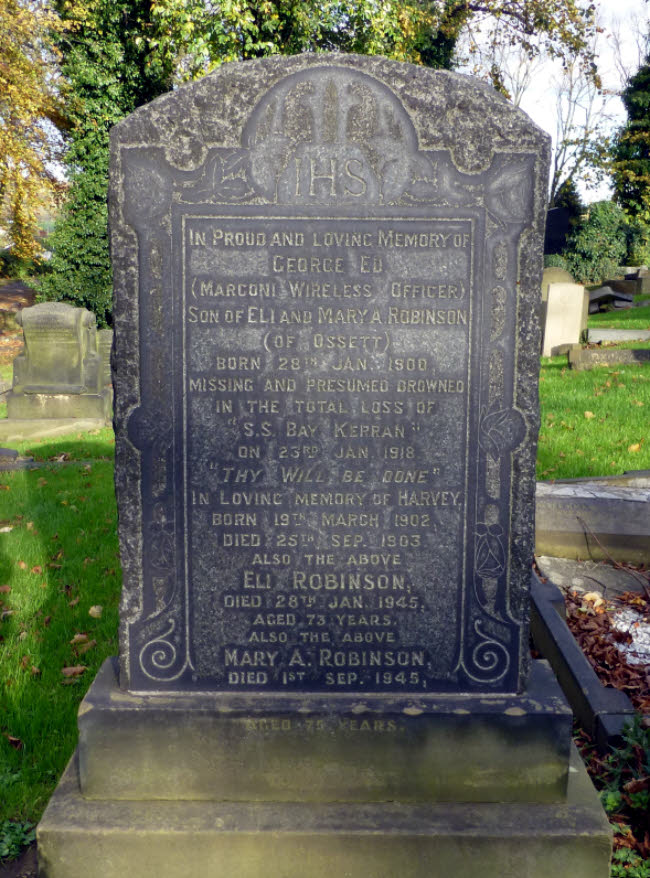
George Edward Robinson was born on 28th January in early 1900, the youngest surviving son of three sons and a daughter born to Eli Robinson and his wife, Mary Ann (nee Peace), who married in Summer 1893. They had five children from their marriage, but one child had died before April 1911.
In 1901, the Robinson family were living on Storrs Hill Road, Ossett and by 1911, Eli, Mary Ann and their four children, Harry, Herbert, Doris and George Edward had moved to a five-roomed house at West Wells Road, Ossett. Eli Robinson was a reg merchant working on his own account.
George Robinson was the 18 year-old Marconi wireless operator on the S.S. “Bay Kerran”, a 3,755 ton merchant ship, 362ft long and 48ft wide, built in Glasgow in 1906 and launched as the S.S. “Kilkerran”, but she was later renamed as the “Bay Kerran”.
On the 19th January 1918, the British steel cargo ship, S.S. “Bay Kerran” left New York for St. Nazaire, France with a cargo of 5,652 tons of grain and a few days later went missing during an Atlantic storm. A wireless distress message was picked up by several ships off the U.S. Coast on the 23rd January from the S.S. “Bay Kerran” asking for assistance and stating that her lifeboats were lost and that she was disabled. All 41 crew on board were lost.
The ship sent out distress calls at a position of 41.14N, 54.10W, then disappeared, and was posted missing by Lloyds on the 3rd April 1918. A weather report for January 1918 indicates that there was a record low pressure over North America with a consequent high pressure over the North Atlantic. In the very heavy weather, the S.S. “Bay Kerran” probably had engine failure or the steering failed. In either case, steering would have been lost in the heavy seas. The ship would have ‘broached to’, causing the cargo to shift, at which point it would have capsized.
The S.S. “Bay Kerran” was carrying three fully-armed Royal Marine Light Infantrymen, such was the concern about German U-Boat attack as the ship got closer to Europe. There is no question of the ship being sunk by German U-boat at the position she was lost, since this was beyond the range of the U-boats of the German Navy in 1918. There was a virtual famine throughout Europe by 1918, so men were required to guard all food shipments. This duty was given to reservists that had already served time before and during the war.
The “Ossett Observer” 1 had this obituary for George Edward Robinson:
“Unknown Fate Of An Ossett Marconi Operator – Feared Loss Of His Ship – Mr. and Mrs. Eli Robinson of Westfield-street, Ossett, have received distressing news relating to their son, George Edward Robinson, who is a Marconi wireless operator in the mercantile service. He was on the steamship Bay Kerran, the owners of which, the Bay Steamship Company, write: ‘We deeply regret to inform you that we have had a wireless message, saying that this vessel was in difficulties, with all her boats gone, about 500 miles south of Nova Scotia, and asking for assistance. An American cruiser reports having searched in the area indicated by the steamer for a considerable period, but they could find no trace of her, and express the view that they fear the ship was lost, with all hands.’ In the absence of more definite information, the parents of Operator Robinson are naturally in great suspense, and cling to the hope that he may have been rescued. This was only the lad’s second trip as a wireless operator. He trained as a wireless operator at the North-Eastern Wireless School in Leeds, and made such progress that he secured his first-class proficiency certificate last August when only 17½ years of age, and at once became wireless operator on the Bay Kerran. He was the sole operator on the vessel, which in view of his age, is a tribute to his skill. The ship sailed from France on her last trip across the Atlantic to Newport News and Portland, and had called at New York on the 18th January, when Robinson last wrote to his home. Before taking wireless telegraphy he had been an enthusiastic boy scout, and had qualified as a King’s scout.
His two brothers are in Egypt. One has been home on leave for only 48 hours since he joined the Royal Engineers (wireless section) three years ago, and the other one has never been home since enlisting 2½ years ago.”
George Edward Robinson, aged 18 years, son of Eli and Mary Ann Robinson, died on the 23rd January 1918 when the S.S. “Bay Kerran” was lost at sea with all her 41 crew. George Robinson has no known grave and was presumed drowned.
Even though George Edward was a Marconi Wireless Operator aboard a Merchant ship he was a civilian and not a member of the Merchant Navy or any of the Armed Forces. As a civilian death he did not qualify, in WW1, for commemoration by the Commonwealth War Graves Commission. Moreover the subsequent historical consensus is that his ship, the Bay Kerran, was lost at sea due to bad weather and not as a result of enemy action.
Nevertheless George Edward Robinson is remembered at Ossett War Memorial as one of The Ossett Fallen because he was remembered on the 1928 Commemoration Programme for the Unveiling and Dedication of the Ossett War Memorial. He is also remembered on the Ossett Holy Trinity and the Ossett Central Baptist Church Rolls of Honour.

Above: George’s parents Eli and Mary Robinson remembered their lost son on a grave at Horbury Cemetery, where they are buried along with an infant brother Harvey Robinson. Photo courtesy of Helen Bickerdike.
References:
1. “Ossett Observer”, 23rd February 1918